Using Food Rewards in Your Dog Training
Today we are going to talk about how using food rewards can affect motivation while training your dog.
Outside of normal feeding there are two applications for using food with dogs:
- Reward or motivator during training
- Toys to pass time while the dog is alone
Every dog, no matter the age, breed, sex, or size, responds to two basic motivators:
- The pursuit of pleasure
- The avoidance of displeasure
When food and treats are used properly, they will become a powerful tool for motivating your dog during training or occupying your dog's time when you are gone and he is alone.
Most people do not give a lot of thought to the kind of treats they use. They underestimate how important it is to vary the treats used in different applications. I must confess that I fell into that category for many, many years. I thought cutting up hot dogs was all that was needed for obedience training or teaching my dog to track.
I started taking dog training seriously back in the dark ages of the 1960s, when people like William Koehler and Winifred Strickland were considered experts in the field. Using food to train dogs back then was almost unheard of.
The argument was, "If you train with food, at some point you're going to have to stop and then what will you do?"
Well, dog training is lightyears ahead of where it was back then and this question has been answered. Koehler and Strickland have become the model-T ford of the training industry. They got you around but it wasn't pretty.
We have since learned that when it's done properly, motivating a dog with food creates a dog that enjoys training, wants to take part in the learning process, and becomes a problem solver. Using treats in your work also improves the bond between dog and handler.
When a handler embraces the fact that he will use food in his training, he must then learn how to do this correctly. Marker training (or clicker training) is hands down the best way. I have a free article, a DVD, and an entire online course on marker training because it works.
Marker training opened our eyes to the fact that different dog treats can produce different results in our training. I am going to talk about that later.
So just as important as it is to learn how and when to use food in dog training, is also what kind of food to use.
Back in the early 1980s, my DVDs showed how to cut up small pieces of hot dogs and use them as treats during obedience training. There is nothing wrong with doing that today.
But in the past 25 years, we have seen a huge improvement in the number and quality of dog treats that are available.
Feeding dogs an all-natural diet has become popular because people like myself recognized the fact that most commercial dog foods are crap. This was dramatically demonstrated with the recent pet food recall that killed thousands of animals.
In fact, over the last 6 or 7 years, the popularity of feeding an all-natural diet has fueled the explosion of all-natural dog treats.
Fifteen years ago, the multi-colored grocery store dog biscuits that are still sold in Walmart or the pet food warehouses were pretty much the only option people had if they wanted a dry food treat. Most dogs that have been fed a raw all-natural diet will justifiably not eat them. God only knows what they are really made from.
Different Treats for Different Jobs
These days, there are a variety of all-natural dog treats we can choose from. It's important you have a variety of all types for several reasons:
- The treats my dogs love may not be the treats your dog love.
-
All treats carry a different motivational value to your dog. It's your job to constantly think about your dog's reaction when you use a specific food treat.
Learn to read your dog's reaction to them. Some treats have so high of a value, they cause a dog to stop thinking. Some dogs can't focus when they know you have a high-value treat on you.
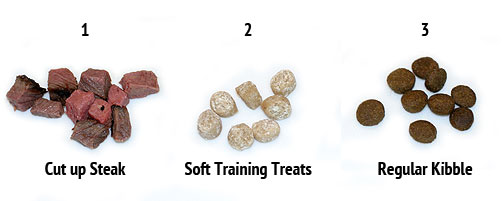
Treats are ranked from most favorite to least The treats that make your dog go crazy shouldn't be used as a motivator on complex tasks that require a dog to think a lot. A difficult task requires the dog to focus on what he is doing. He can't focus if he's thinking about the steak you're about to give him. Ideally, difficult tasks should be rewarded with a mid-level value treat.
-
Some exercises require lower value treats. Trainers need to be aware of these exercises and then be prepared to use the treat with the correct value for the work you're doing.
I will reward my dog for coming to me when on a walk. In that circumstance, I don't mind if the treat is crunchy and takes a couple of seconds to eat like our Charlee Bear Grain Free Crunch.
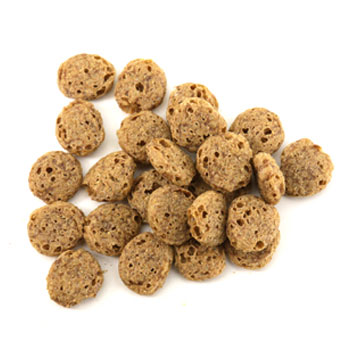
On the other hand, during training, I want the treats to be very easy to eat. I want them to be gone almost instantly so we can continue on with training. The softer treats like Bocce's Bakery Training Bites are perfect for this.

These are only a couple of examples. As you gain experience you will find many other examples. View all of our available all-natural treats.
-
Using food treats in Treat Toys.
We sell a number of toys that can be loaded with dog treats. These Treat Dispensing Chew Balls are the best I have ever seen.
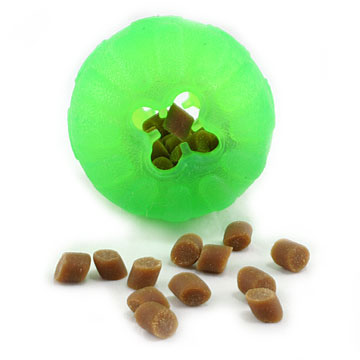
The size of the opening in a treat toy will determine what food treat you buy. We will to use a trail mix in these toys. We will put some larger treats like the Fresh is Best Freeze Dried Treats or Green Mountain Treats along with some of the smaller treats like the Chewy Tricker Trainer Treats to form a trail mix of treats in the toys. The smaller treats will dribble out and reward the dog for trying while the larger treats stay inside and pique the dog's interest.
The dogs that are real food hounds quickly learn out how to quickly unload a treat toy filled with small treats. These dogs should only have large treats in them that are difficult to get out.
Once the dog learns how to empty a toy, you can often go to a more difficult treat.
Bottom line is I don't want my dog to become discouraged, I want them to be occupied. This is where paying attention to detail pays off. It is a constant balancing act to find the right mix for the right toy for your dog.
If you ever watch any of the documentaries on zoos, you will see that the better zoos work hard to come up with different ways of using food to stimulate the animal's minds. They hide it in logs or freeze it in big ice blocks or a million other things just to keep the animals busy.
We can do the same kinds of things with our dogs. Use your imagination. If you have to leave your dog in a crate while you're at work during the day and you feed an all-natural diet, why not take these treat toys and fill them with the dog's daily ration of food and freeze them overnight? This will keep the dog busy for hours.
Learning to use the various treat toys in different applications can accomplish the same thing.
-
Some treats have a longer shelf life than others. This is important if you carry treats in your coat pockets or bait bags. Some treats are quick to get slimy and moldy but these are often the treats that the dog can quickly eat, which is important for marker training.
You will need to think about how you carry the treats and how long you intend to have them in your pocket or a bait bag.
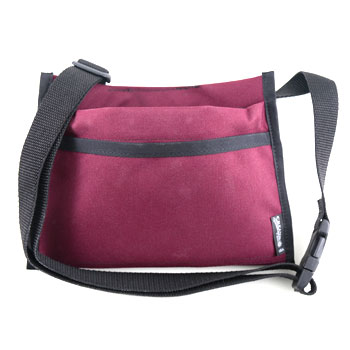
- Some treats take longer to eat than others. How long it takes a dog to eat a treat has a bearing on when and how it's used.
Always Try a New Treat Before Training With It
I always recommend letting a dog sample a treat as soon as you get a new one. Don't wait until you drive to training classes before letting the dog try a new dog treat. Check them out at home first.
We try every treat we sell on our dogs before we make the decision to sell the treat. But with this said, just because a product is labeled a dog treat does not mean that your dog agrees with the labeling.
The first time you use a new treat, dogs will play around with it before they actually eat it. It's like they need to convince themselves that it is indeed a new dog treat. Many times, once the dog eats a few treats he decides they're pretty darn good after all and he downs them quicker.
If you made the mistake of trying to use a new treat as a reward too soon during training, you could find yourself standing around, getting frustrated while you wait for the dog to eat it. This just breaks the flow of your training.
Our Criteria in Selecting a Dog Treat
We are always looking for new healthy treats to use in our training. When it comes to food rewards, variety is the spice of life. Changing the food rewards keeps your dog's interest and they become motivated to get a new and different tasty treat.
When we hear of a new treat, the first thing we do is review the ingredients. While we are very particular in what we allow our dogs to eat for their main diet, we are not as critical in our dog treats. We will occasionally allow them a bit of doggy junk food in the treats because it's not like it's a huge part of their diet.
If the ingredients look okay, we buy some treats and use them in our training. If our 5 or 6 dogs don't like the treats, we don't sell them.
There is an article about feeding a raw all-natural diet if you have an interest in learning about this.
My Dog is Not Much of a Chow Hound
Some dogs seem to be absolutely food-crazy chow hounds while others don't seem to have much of an interest in food.
As a general rule, every dog can have food drive. Some just have way more than others. There are a lot of reasons why some dogs don't seem interested in food:
- Dogs must be hungry for a food reward to mean a lot to them. So people who train with food should change their feeding schedule so they feed the dog after training and not before.
-
Start training with a high-value food reward, like pieces of steak. This will often trigger the dog's interest and motivate him in training.
There is nothing wrong with cutting up steak leftovers into small chunks and using them. Once the dog has learned that food rewards are a part of the training, you can then change to various all-natural treats that fit your training needs.
-
Some low food drive dogs are simply too fat, an uncommon problem with dog owners who love their dogs. For overweight dogs, cutting back on the daily food rations is always a good idea.
Dogs should never be free fed and they should always be kept thin. By thin, I mean there should be a definition between their rib cage and their loins. A thin dog is a healthier dog that lives longer.
-
Letting the dog go a day without food will increase almost every dog's food drive. As a rule, one would not want to go more than two days without feeding.
In studies with rats, there is a diminishing return on a rat's motivation and learning ability after going 3 days without food.
-
Do not get in the habit of feeding the dog right after you train. Wait for 2 or 3 hours.
Some lazy dogs will pick up on the fact that right after training they always get their nice big bowl of food. These dogs will not try as hard for a food reward because they know that one way or another, they are going to get fed real soon.
It seems that this phenomenon goes away if there is more than an hour break between training and feeding. So randomly increasing and decreasing the feeding times works as long as it's an hour after training.
-
Dogs that are well-fed may have to learn that all food comes from your hand. As I mentioned, we feed a raw all-natural diet.
I have a young male that did not have a ton of food drive so I changed his diet to all hamburger and let him go a day without food. Then for 4 or 5 days, the only food he got was hamburger from my hand during marker training.
Now remember, when you fast a dog for a day and then bring out the hamburger, the meat is going to be a high-value treat for the dog. So you are going to see the dog be a little more hectic than normal. That's okay. Our goal here is more to teach the dog to appreciate the value of food treats rather than to train a complicated task. So we only ask the dog to do very simple things that he already knows like a hand touch or a SIT or DOWN.
During this initial work, if he zoned out and did not pay attention, I simply took him by the collar, without saying a word, and put him in his dog crate and walked away for 3 or 4 minutes.
That experience did wonders for his food drive. After a week, we went back to normal feedings—always several hours after training.
This same concept applies to a dog's toys. Teaching a dog that he only plays with toys when you give them to him. After playtime is over, we take the toy away. This builds drive or motivation for toys. Doing this makes toys a tool in your training as a motivator, similar to treats.
-
If your dog blows you off during your training, another approach is to simply stop, take the dog by his collar, and put him in his dog crate. Get another dog (we are very lucky because we have an unlimited supply of food hounds) and let the second dog eat the first dogs' daily bowl of food right in front of the crate.
Don't for a second think this doesn't say volumes to the dog you're training. You only need to do this a couple of times before he gets the picture.
A caveat here is that you should get in the habit of feeding these dogs inside their dog crates. This will eliminate the possibility of dog fights.
All-Natural Treats vs. Meat Treats
You will probably find that cooked meat or raw meat cut into small chunks are your dog's favorite food treats. Using them in training is great, but you may also get to the point where having to cut up meat every day is more than you care to do. This is where the all-natural treats come in.
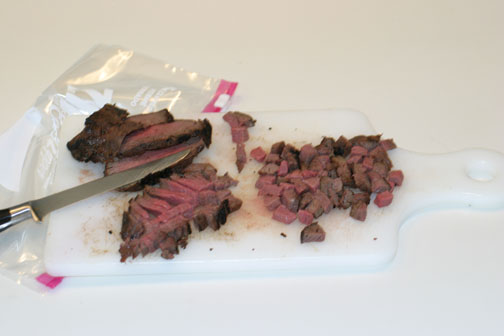
What we have found our dogs like is when we make a trail mix of dog treats. We will put pieces of cut up meat, pieces of string cheese, and several kinds of all-natural treats in a plastic tub or fridge. We fill our bait bag from this tub.
When we go out, we randomly select a treat from this trail mix. The variety of this random selection builds interest in our dogs because they never know what the next treat reward is going to be.
What Size of a Treat to Use
Have you ever watched a dog eat a piece of steak? Unless the piece of meat is huge, they take it in their mouth and virtually swallow it.
I find myself thinking, “Hey dummy why didn't you chew that a little and make it last a little longer?”
The fact is that dogs derive pleasure from the physical act of eating. Your dog would get more pleasure out of eating a steak that has been cut up into 30 pieces than if he ate the entire piece in one swallow.
The correct size of a food treat is the size of an eraser on a pencil. We want our dog to eat a treat as quickly as possible so we can move on with training. Small treats also allow for multiple treats being given one right after the other in sustained training. This is where you will feed one treat after another to extend the duration in an exercise (like the DOWN STAY).
So, even though the treats you purchase may be a good size when they come out of the bag, you should break them up into smaller pieces.
Some of the larger treats can be broken into about 10 smaller pieces. As I break mine up, I always wonder how many people don't do that and simply waste 90% of the value of these treats by feeding the entire chuck.
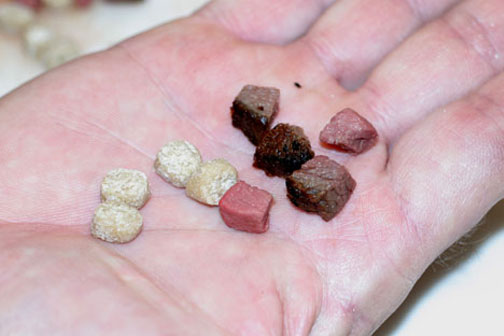
Vary the Amounts and Placement of Reward to Affect Drive
Small treats allow trainers to “JACKPOT” their treats. This is where they will occasionally reward the dog with a number of treats all at one time (hence the name jackpotting). This can be a real motivator to the dog who really does something good. It's on the same principle as winning a jackpot on a slot machine.
If you are familiar with marker training, you know that placement of the food reward is an important part of the learning process. By this, I mean if you are training the dog to do a hand touch, the reward is always placed on the hand that your dog touched with his nose.
When trainers have a lower drive dog, simply making the dog move to get a reward will often increase motivation. Making it jump up a little will increase drive. So with these kinds of dogs, don't just stick the food in its mouth. Make him work for it.
Varying Timing on a Reward
I would like to take a minute to talk about how the timing of food rewards can affect performance. This will not apply to pet owners but rather to people who intend to compete in various dog sports.
By “timing”, I don't mean the concept of how to mark or click a behavior in marker training within 1.5 seconds.
Rather, I want to pass on an interesting concept that is seen on studies with training rats. If a rat is trained to run a maze and it is usually rewarded halfway through the maze with a food reward, and then that food reward is withheld, the rat will run the last half of the maze quicker than when it normally gets the reward halfway through.
Now how does this relate to your dog training? Well, think about it.
An agility routine is 30 seconds long, a Schutzhund obedience routine is over 15 minutes long, and a Mondioring routine is 45 minutes long.
If you compete in dog sports, can you wrap your mind around this concept and experiment with ways to improve your dog's performance? I can't do it for you. This has to come from the trainers and how they read their dogs.
Varying the timing on rewards will need some experimenting but you will soon come to find that doing so helps your dog focus. Of course, there will be a threshold where your dog might go crazy trying to get that treat. But once you find the perfect balance, you will learn how to get the best performance from your dog.
Use Treats to Build Prey Drive
Prey drive is the drive to chase and tug. Trainers can use a dog's prey drive as a reward in training.
Some dogs are born with a great deal of prey drive and some dogs have very little prey drive. Some dogs can have prey drive but as soon as they think there is food around, the prey drive goes away. Morgi the Corgi (one of our house dogs) is a perfect example of this. She has nice prey drive but she is also a chow hound. The second she thinks we have a food reward, her prey drive goes away.
Quick movement with food in the hand can trigger the dog's prey drive. Keep in mind that this work is not using food as a reward but rather to build drive.
Putting high-value food treats in a sock and teaching the dog to play tug with the food sock also goes a long way towards teaching low prey drive dogs with high food drive to play tug.
Now these methods will not work for people who intend to train in a biting sport where a dog must have serious prey drive. However, this will work for people who want to compete in agility or obedience and use a treat tug game as a reward.
Your Criteria for Using a Treat
So in the end, every trainer needs to evaluate what their criteria is for training. I recommend making a list. Then break these exercises down into training steps. Once they have done this, they need to give serious thought to how they can use food as a reward. Should they use a high-value food reward or a medium-value food reward?
They also need to know how their dog reacts to various food rewards. This can only be determined by constantly watching your dog and thinking of his response to what you're asking him to do. No one can tell you what to do with your dog. You need to figure it out yourself. Take notes and think about it right after training.
Be prepared to experiment with food treats to learn how to control Motivation. If you're a new trainer, start by looking for the extremes. Look for the extreme high-value treats (there can be more than one). With experience, you will learn to recognize subtleties of difference in how a dog reacts to mid-level treats. Be sure to take notes.
Conclusion
We believe training with food is one of the core foundations of engagement. If you'd like to learn more about training your dog, view the several different resources we offer. Leerburg is dedicated to teaching trainers of all levels how to maintain a bond with their dog while achieving their personal training goals.
Leerburg covers a variety of dog training topics for the new beginner to the advanced veteran. If you're interested, view our following online courses or DVDs for more dog training guidance:
- Basic Dog Obedience (DVD || Online Course)
- Intermediate Dog Obedience (DVD || Online Course)
- The Power of Training Dogs with Markers (2024) (Online Course)
- Training Dogs with Food Rewards (Online Course)
- Training Your Dog to Come When Called (Online Course)
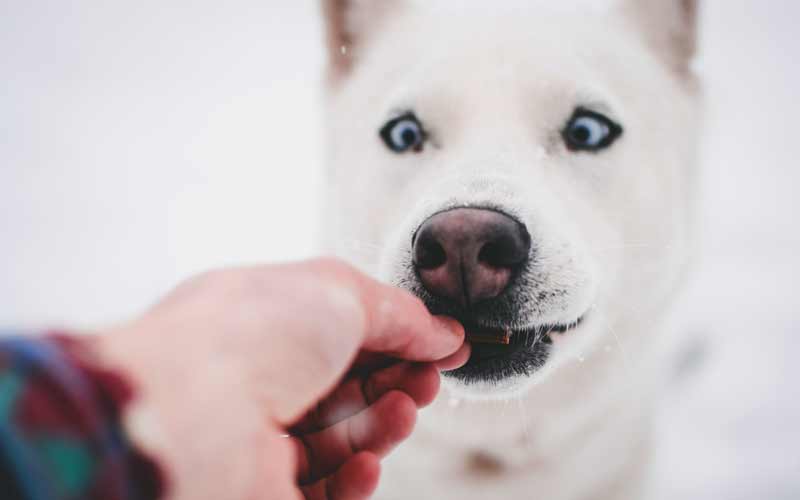
- Leerburg Dog Training Articles
- Leerburg Dog Training Podcasts
- Leerburg Free Dog Training Videos
- Leerburg Dog Training DVDs
- Leerburg Dog Training Courses


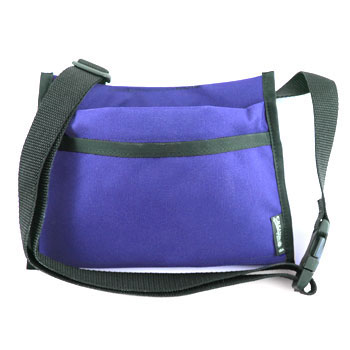
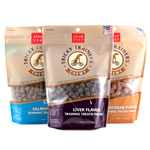

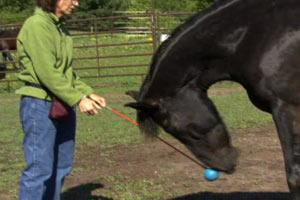
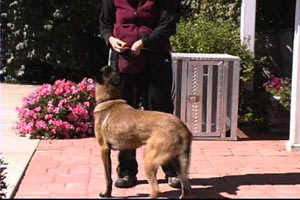

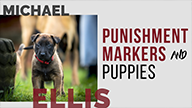
0 Comments
Ask Cindy
Sorry, adding comments is currently disabled.